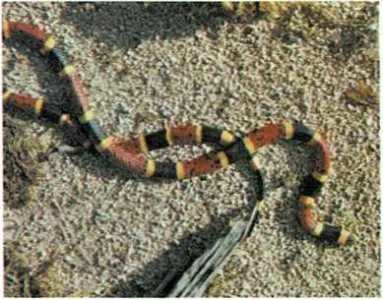Bites and stings
Bites and stings are common hazards of childhood. Some bites and
stings require little treatment—nothing more than washing with soap
and water. Others are serious injuries that call for treatment by a
doctor.
Mammal bites. The mouths of animals contain a variety of germs that
may cause infection or a serious disease. Rabies, one of the most
serious diseases, destroys nerve cells in part of the brain and almost
always results in death. The rabies virus lives in the saliva of many
kinds of animals. The disease is most commonly transmitted by dogs, but
it may also be spread by other mammals, including cats, bats, foxes, and
skunks. To prevent rabies, have pet dogs and cats vaccinated. Also
report all strays to the police or health authorities.
The circumstances surrounding the animal bite help determine the
treatment. The child may be bitten by a family pet that has been
vaccinated against rabies. For minor wounds that are no more than a
scratch, wash with soap and plenty of warm water, and rinse
thoroughly. Then cover the wound with a bandage. If the scratch becomes
inflamed, call your doctor. If the bite is a puncture wound, wash the
wound with soap and water, and call your doctor.
If your child is bitten by a stray mammal, wash the wound with soap and
water and call your doctor. If your child has a cut, scratch, or other
wound that comes in contact with the saliva of a stray mammal, follow
the same procedure. If the animal can be captured, it is usually kept
under observation by a veterinarian to find out if it has rabies. If
your doctor suspects that the animal has rabies, the doctor will start
rabies inoculations for the child immediately. If the animal cannot be
captured, the doctor may give the injections as a precaution.
Ratbite fever is also transmitted through a bite. If your child is
bitten by a rat, wash the wound with soap and water, then call your
doctor or take the child to a hospital emergency room. The doctor may
administer antibiotic and tetanus shots.
A human bite that breaks the skin can also cause a severe infection.
Wash it with soap and water and see a doctor.
Snakebites. If your child is bitten by a snake, it is important to
know whether the snake is poisonous. A nonpoisonous snakebite is no more
harmful than any other animal bite. Wash the bite with soap and water,
then call your doctor.
Recognizing poisonous snakes. There are two types of poisonous snakes
in the continental United States—coral snakes; and pit vipers, which
include rattlesnakes, copperheads, and cottonmouths (water moccasins).
Rattlesnakes are the only poisonous snakes found in Canada.
Poisonous snakes can often be identified by the following
characteristics.
Both pit vipers and coral snakes have two fangs along with their
normal teeth.A pit viper has a pit on each side of its head, between its eye and
its nostril.Most rattlesnakes have noise-making rattles on the end of their
tails.Coral snakes have black snouts and fairly wide red and blackish-blue
bands, separated by narrower yellow bands.
If you cannot find the snake that bit the child, you may be able to tell
if the snake
was poisonous by asking whether the child is in pain, or by observing
the bite area for swelling and discoloration.
The bite of a harmless snake may produce mild pain, but the pain rarely
lasts and it does not spread. A child bitten by a poisonous snake almost
always feels deep, burning pain. If the bite is that of a pit viper, the
pain usually spreads. If the bite is that of a coral snake, the pain
does not spread.
A nonpoisonous snakebite rarely produces swelling. If swelling does
occur, it does not spread. The bite of a pit viper produces swelling
within three to five minutes. The swelling usually spreads rapidly
toward the trunk of the child’s body. The bite of a coral snake does not
cause swelling.
A perfect bite pattern of two fang marks generally indicates the snake
is poisonous. However, the bite pattern is not always a reliable sign
because it may be obscured by marks inflicted by the snake’s other
teeth.
Poisonous snakebites. If your child is bitten by a poisonous snake,
the child needs immediate medical attention. Call a doctor or take the
child to a hospital. If possible, kill the snake and keep it for
identification.
Activity causes the poison to spread more rapidly, so keep the child as
still as possible until medical help amves, or until you can get to a
hospital. Keep the bitten part of the body in a lower position than the
heart.
If the child develops mild symptoms of poisoning and if the bite is on
an arm or leg, tie a bandage above the wound, between it and the heart.
Make sure that you can wedge a finger under the bandage. Do not put the
bandage around any joint. Release the bandage for 90 seconds every 10
minutes to prevent damage from lack of blood circulation.
If the child develops severe symptoms— pain, swelling, numbness,
difficulty breathing— and you cannot get the child to a doctor or a
hospital within 30 minutes, continue first aid. Sterilize a knife or
razor blade and make an “I” shaped cut through—and slightly
below—each fang mark along the length of the arm or leg. Make the
cut no longer than Vz inch (12 millimeters). Cut through the skin, but
not deep enough to sever muscles and nerves. Do not make cuts on head,
neck, or torso.
Apply suction to the cut or cuts with a suction or bulb syringe found in
many first- aid kits. Or, if you have no cuts or open sores in your
mouth, suck and spit out the poison. Rinse your mouth. Continue suction
for 30 to 60 minutes, or until the swelling stops spreading. Take the
child to a hospital.
Insect, spider, and tick bites. Most insect and spider bites are
more annoying than serious. Put calamine lotion, an ice cube, a drop of
household vinegar, or a thick paste of baking soda and water on the
bitten area.
Two dangerous spiders are the brown recluse spider and the female black
widow spider. The brown recluse spider is found in at least 17
states—Alabama, Arkansas, Colorado, Georgia, Illinois, Indiana,
Kansas, Kentucky, Louisiana, Mississippi, Missouri, North Carolina,
South Carolina, Ohio, Oklahoma, Tennessee, and Texas. Because it hides
in dark places—wadded-up newspapers, bedding, clothes, or shoes—it
can be easily transported by travelers to new areas. The black widow
spider is found in nearly every state and in Canada.
Bites from either of these spiders produce a burning sensation, followed
by severe cramps in the abdomen, chest, and legs. If you suspect that
your child has been bitten by a brown recluse spider or a black widow
spider, call your doctor.
Ticks are parasites that suck blood through a hooked beak that they fix
tightly in their victim’s skin. Children who have been in tick-infested
areas should be examined carefully for ticks, especially along the
hairline.
A few drops of turpentine or alcohol will make a tick loosen its hold.
Holding a hot match or lighted cigarette near the tick may also be
effective. Working gently and slowly, remove the tick with tweezers or a
piece of paper. If you tear the tick loose, its mouth or other body
parts may stay in the skin and cause festering sores. Also avoid
crushing the tick. Ticks often carry germs, which they transfer to their
victims. Scrub the area from which the tick is removed with soap and
water for five minutes. If the bite becomes inflamed and swollen, or if
the child runs a fever, becomes weak, or develops a rash, call your
doctor, [m.g]
See also Allergy; Lyme disease
Common poisonous spiders and snakes
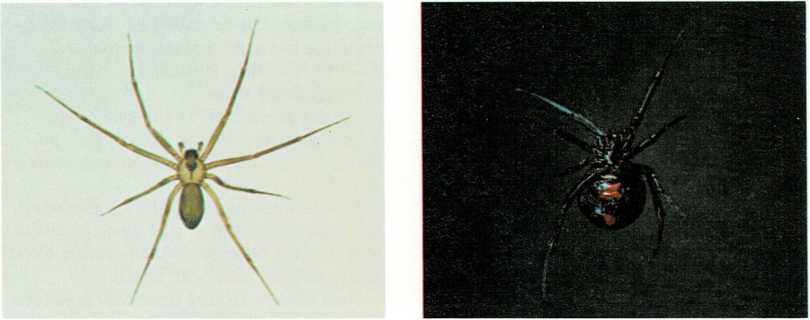
Both the brown recluse spider (left) and the black widow spider
(right) have distinguishing marks. The brown recluse spider has a dark
violin shape on its back. The black widow spider has a red or yellow
hourglass shape on its abdomen.
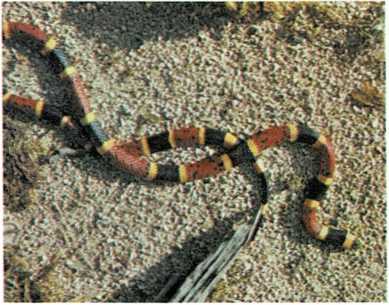
The best way to identify a coral snake is to remember the distinctive
color pattern — red bands touch yellow bands.
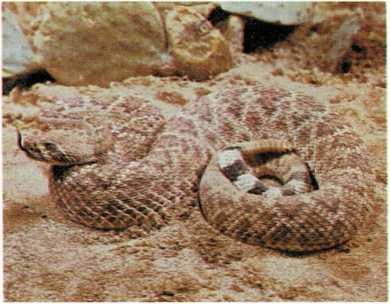
The body of the western diamondback rattlesnake has a pattern of brown
diamonds, edged with a light-colored border.
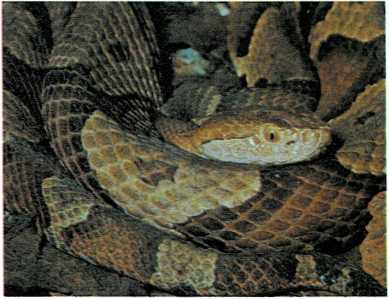
The copperhead has broad, brown, X-shaped bands on its light-colored
body.
The top of its head is copper colored.
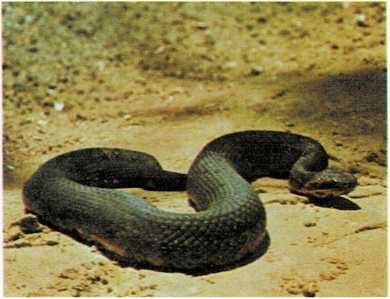
**The eastern cottonmouth usually has broad dark bands on its body. This
pattern may become obscure as the snake grows older.

